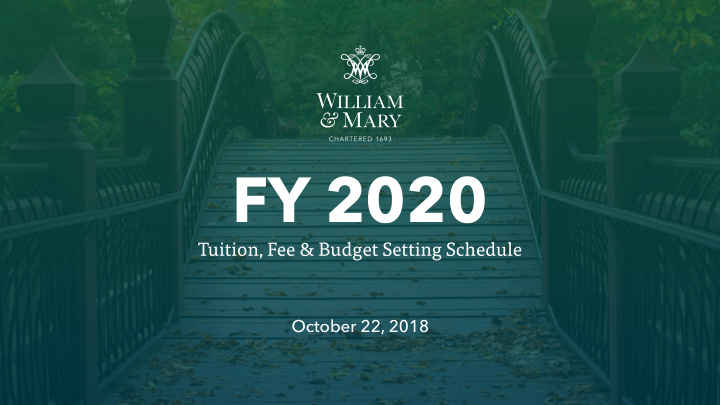



FY 2020 Tuition, Fee & Budget Setting Schedule October 22, 2018
FY 2020 Tuition, Fee and Budget Setting Schedule STEP STEP STEP STEP STEP STEP 4 5 2 3 1 6 1 SEPTEMBER 28, 2018 OCTOBER 22, 2018 NOVEMBER 16,2018 DECEMBER 2018- MARCH 2019 APRIL 26, 2019 MARCH 2019 Board of Visitors adopts Public comment session Board of Visitors sets in- Public comment session Board of Visitors sets FY revised Six-Year Plan with on in-state state undergraduate on out-of-state 2020 tuition rates for all FY 2020 state funding lower tuition assumption undergraduate tuition tuition for undergraduate, graduate student groups and allocation for academic and budget priorities FY 2020 and professional approves the FY 2020 programs and student fj nancial aid set by tuitions, mandatory Operating Budget fees, and budget Governor and General priorities Assembly
What are W&M’s primary sources of funding and how are they used? SOURCES USES Instruction 118,404,200 Tuition 201,860,000 Libraries, Academic Technology, Deans 32,504,000 State Taxpayer Support 48,600,000 Registrar, Career Services, Financial Income from Endowments and 10,027,000 14,548,000 Aid Office, Admissions Spendable Donations Institutional Support, including HR, 115,342,000 Student Fees, Sales and Services 33,226,000 Police, Financial Services, Admin, IT, etc. 32,050,000 Grants and Contracts Facilities Operations & Maintenance 19,722,000 TOTAL 1 $412,400,000 Financial Aid 51,150,000 Research & Public Service 2 34,036,000 Student Housing, Dining, Athletics, 111,586,000 NOTES: and other Non-Academic Services 1 Affiliated foundations provide over $40 million in additional annual operating support to the university. 2 Research and Public Service includes externally sponsored research TOTAL $410,655,000 supported by grants and contracts as well as state-supported research.
Almost 50% of Operating Revenue Comes from Student Tuition 11% ALL OTHER | $46.6 12% STATE TAXPAYER SUPPORT | $48.6 28% STUDENT FEES, SALES & SERVICES | $115.3 49% TUITION | $201.9
Funds are Spent in Four Major Areas USES 27% Instruction 118,404,200 $111.6 AUXILIARY Libraries, Academic Technology, Deans 32,504,000 SERVICES Registrar, Career Services, Financial Aid Office, Admissions 10,027,000 $ Institutional Support, including HR, Police, Financial Services, 33,226,000 Admin IT, etc. 8% IN MILLIONS Facilities Operations & Maintenance 19,722,000 $34.0 RESEARCH & PUBLIC SERVICE Financial Aid 51,150,000 Research and Public Service 34,036,000 Student Housing, Dining, Athletics, and other 111,586,000 52% 13% Non-Academic Services $213.9 $51.2 ACADEMIC TOTAL $410,655,000 FINANCIAL AID ENTERPRISE
Tuition supports over 75% of the academic enterprise and need-based aid SOURCES ($ IN MILLIONS) OPERATIONAL AREAS % SUPPORTED BY GIFTS, SUPPORTED BY STATE TAXPAYER TUITION TUITION TOTAL DONATIONS & TUITION 1 SUPPORT OTHER 2 ACADEMIC ENTERPRISE $161.3 $44.1 $8.5 $213.9 75.4% FINANCIAL AID $40.5 $4.4 $6.6 $51.5 78.6% TOTAL $201.8 $48.5 $15.1 $265.4 76.1% NOTES: 1 Excludes research and auxiliary enterprises which are not supported by tuition. 2 Excludes $40 million in additional operating funds provided through affiliated foundations to support the university’s mission.
Adjusting for In fm ation and Enrollment, State Support has Declined STATE GENERAL FUND SUPPORT PER IN-STATE FTE IN 2019 CONSTANT DOLLARS *27% DECLINE SINCE FY99 *Note: State provides no funding for out-of-state students
How is each tuition dollar spent? 18¢ 12¢ 47¢ NEED BASED FINANCIAL AID LIBRARIES, ACADEMIC DIRECT INSTRUCTION TECHNOLOGY, DEANS (including faculty compensation) 11¢ 8¢ 4¢ INSTITUTIONAL SUPPORT OPERATING & REGISTRAR, CAREER (HR, FINANCE, POLICE, IT) MAINTAINING FACILITIES SERVICES, FINANCIAL AID OFFICE, ADMISSIONS
How is tuition set? SETTING PRIORITIES: KEY QUESTIONS 5. Are there new programs or services that 1. Are current expenditures adequate to are needed? meet the needs of the academic enterprise? 6. Are there programs or services that we can eliminate? 2. Are there opportunities for cost savings? 7. What incremental funding is needed to 3. What’s the appropriate faculty-student meet need-based aid goals? ratio? Are additional faculty needed? 4. Is faculty compensation competitive? Is W&M able to a tu ract high caliber faculty?
Proposed Tuition Range for Incoming In-State Undergraduates CONTINUING IN-STATE UNDERGRADUATES Tuition for current in-state undergraduates will not change based on W&M’s four-year tuition guarantee. TUITION RANGE: 0% INCREASE INCOMING FRESHMEN & TRANSFER STUDENTS With the four-year tuition guarantee, a 3% - 5.4% increase is equal to a 0.74% - 1.31% annual increase. TUITION RANGE: 3% - 5.4% INCREASE
The Bottom Line THE VALUE PROPOSITION Is W&M tuition cost-competitive given the value and quality of the education students receive?
What are your priorities? Open for Comment
Recommend
More recommend